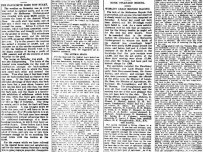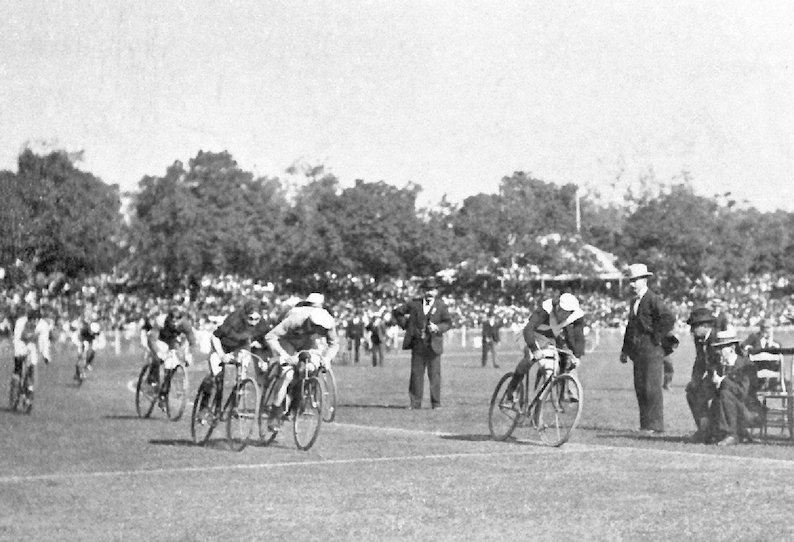Over the course of 114 editions of the Austral Wheelrace, many great cyclists have taken the honours, including Sid Patterson (1962 & 1964), Danny Clark (1977, 1986 & 1990), Stephen Pate (1988, 1991, 1993 & 1999) and Shane Perkins (2009).
With a story stretching back to 1887 and prizes consisting of anything from grand pianos to cabinets filled with silverware, the event has created its fair share of Australian cycling history.
In fact, the Austral was perhaps the birthplace of the Malvern Star. This historical bike which went on to be associated with legends such as Sir Hubert Opperman and Sid Patterson.
The story of Malvern star begins with Tom Finnigan. Finnigan was an active cyclist and member of the Albert Park Cycle Club but had only seen limited success. His big chance came when he entered the Austral Wheel Race in December 1898.
At the time Finnigan was employed as a bicycle mechanic by the local arm of the Canadian bicycle company Massey Harris. He was also a regular professional cycle racer, but no champion. For the 1898 “Austral” he was handicapped on 220 yards. The first prize of 240 sovereigns was a large sum in those days, enough to set a young man up for life.
Heats for the highly prized two-mile handicap at the MCG began with some controversy. Both the backmarkers and the press were expressing great concern about the quality of the frontmarkers out on such big starts. The press commented, “It was remarkable to see how some of the men who have almost qualified themselves to ride alongside a hearse, suddenly brightened up and did wonders.” Only heat winners and some fastest seconds qualified for the final and in slightly unusual form, many frontmarkers had agreed to work together to ensure the elimination of the better opponents behind them.
Tom Finnigan, born in Gisborne, only in his third season of racing at 26 years of age, was one such marked as generously handicapped on 220 yards. He won the fifth of the 11 heats easily, by a margin of five lengths, although he only had one double win at Sale previously to his credit.
Betting on the event, legal, but beyond the control of the League of Victorian Wheelmen, had an unpredictable influence on the conduct of the heats, as evidenced by the sea of torn and discarded tickets littering the betting enclosure.
With 30,000 spectators at the final including His Excellency the Governor and Lady Brassey, who were great cycling fans, the crowd and atmosphere were electric.
The Argus newspaper was very enthusiastic about the day with comments made: “The meeting was one of the most pleasant that had yet been held by the Melbourne Bicycle Club” and … “the best day ever known … fast and brilliant.”
In the final, the back marker was W.C Jackson on 40 yards and out front was A.W. Bennett on the arguably excessive 300 yards which provided for a much more open event than today (with only 250 metres available). The front markers worked fairly cooperatively again but bunches variously formed and disintegrated during the eight laps on the grass track. There also appeared to be a little bit of outside assistance happening as whistle signals were being blown from the spectator area, apparently telling certain riders to go faster or wait.
 Finnigan was said to be one of the recipients of those signals but he did much of the front running over the last few laps and led from the bell for his narrow win by half a length. His winning time was 4 min. 30.8 secs. Second was W. Middleton (190 yards) and third was G.C. Macgibbon (230 yards). The win was worth a massive 240 gold sovereigns – a massive pay day in the 1890s.
Finnigan was said to be one of the recipients of those signals but he did much of the front running over the last few laps and led from the bell for his narrow win by half a length. His winning time was 4 min. 30.8 secs. Second was W. Middleton (190 yards) and third was G.C. Macgibbon (230 yards). The win was worth a massive 240 gold sovereigns – a massive pay day in the 1890s.
The win proved to be fortuitous for cycling in Australia as Finnigan set up his own bike shop at 58 Glenferrie Road, Malvern and in 1903 began building and selling his own brand of bikes which he named Malvern Star.
In the face of strong competition from larger English and American firms, local bike shops such as Finnigan’s prospered and multiplied. Finnigan was able to gain the endorsement of Don Kirkham, then one of the best known cyclists in Australia.

The descendent Finnigan family still run a bicycle shop today in nearby High Street, Northcote with a mural of the great race on outside of the shop.
Finnigan retired in 1920, selling the business to a 24-year-old named Bruce Small for 1125 pounds. Small expanded the operation greatly when in 1921 a 17-year-old Hubert Opperman won prizes donated by Small and started working with Malvern Star. Future Australian champions would be known for riding the Malvern Star, including Sid Patterson, Ian Browne, Tony Marchant, and the Australian foursome who won the Olympic Teams Pursuit gold in Los Angeles in 1984.
The 115th Austral Wheelrace takes place on February 23 at DISC Velodrome which should again prove to be another historical night. More information at Victoria Cycling

